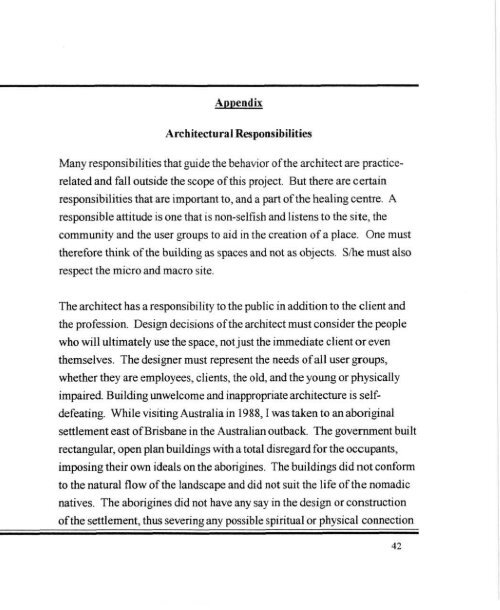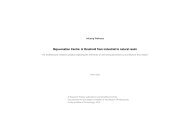Bruneau_1998 (1)
You also want an ePaper? Increase the reach of your titles
YUMPU automatically turns print PDFs into web optimized ePapers that Google loves.
A fytreat Centre for 'Wftok<br />
tfzatth<br />
to the buildings. As a result, the buildings were defaced and literally torn<br />
apart. By housing the aborigines in inappropriate lodgings, they were<br />
robbed of their spiritual relationship to the world, destroying the roots of<br />
their culture. This is an extreme example, but nevertheless illustrates the<br />
issue.<br />
The architect's responsibilities extend to the environment, the place we live.<br />
Every time we transform our environment, the entire earth is affected. The<br />
impacts range from the benign to the extremely harmful. The architect must<br />
not contribute to environmental deterioration. The ripple effects of using<br />
chemically-laden materials or rare and exotic woods can be experienced<br />
worldwide.<br />
In order to minimize adverse effects on the planet, the architect can impose<br />
a number of concepts. These include: maximizing heat energy using a focal<br />
heat source and reusing waste heat by means of passive and active heat<br />
exchangers, reusing water wherever possible and using renewable sources of<br />
energy like wind and solar power. Also, when selecting materials, the<br />
architect must avoid tropical woods, plastics with destructive manufacturing<br />
methods and heavy chemical based products, whether they are paints, plys<br />
or carpets. The negative effects are twofold. First, toxins pollute our<br />
natural environment and second, there are adverse biological effects on the<br />
occupants and passers-by. It is critical that design decisions are formed by<br />
ideas in sustainability, while remaining friendly to our ecology and<br />
environment.<br />
43



